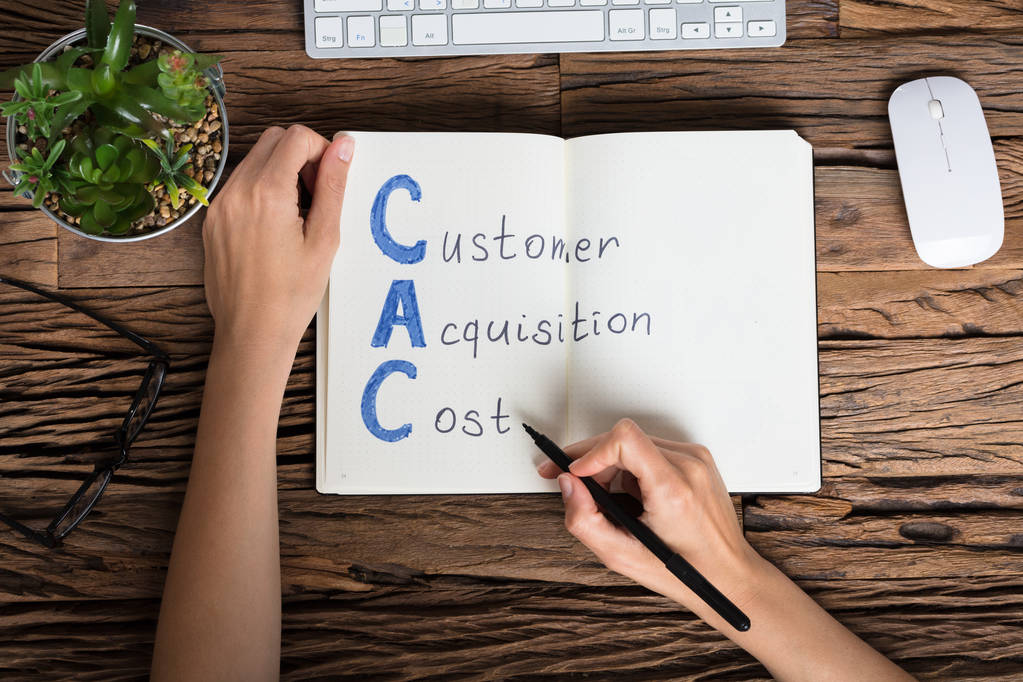Welcome to the world of customer acquisition! In this article, we’ll delve into the ins and outs of understanding your Customer Acquisition Cost (CAC). Strap on your learning cap and get ready for an adventure in the world of business strategy and metrics.

Defining Customer Acquisition Cost (CAC)
Before we go any further, let’s make sure we’re all on the same page. Customer Acquisition Cost, or CAC for short, is the amount of moolah you spend to acquire a new customer. It encompasses all the resources, time, and effort you pour into getting those precious customers through the door.
But let’s dive a little deeper into this concept, shall we? Imagine you’re a business owner, and you’re on a quest to attract new customers. You invest in various marketing strategies, hire a talented sales team, and spend countless hours perfecting your pitch. All of this comes at a cost, and that’s where CAC comes into play.
Importance of CAC in Business Strategy
Why should you care about CAC? Well, my dear reader, your CAC is the bread and butter of your business strategy. It’s the secret sauce that helps you understand how much you need to invest in acquiring customers and whether your marketing efforts are paying off. Think of it as your superpower in making informed decisions that’ll grow your business.
By calculating your CAC, you gain valuable insights into the effectiveness of your customer acquisition efforts. You can determine which marketing channels are bringing in the most customers, which sales strategies are yielding the highest conversion rates, and where you should allocate your resources for maximum impact.
But wait, there’s more! CAC also helps you evaluate the profitability of your customer base. By comparing your CAC to the lifetime value of a customer (the amount of revenue they generate over their relationship with your business), you can determine whether your acquisition costs are justified and whether you’re attracting the right type of customers.
Components of CAC
Now that we’ve established the importance of CAC, let’s break it down into bite-sized pieces. CAC consists of three main ingredients:
- Marketing Expenses – Oh, the expenses we endure to promote our beloved products and services! These include things like advertising, social media campaigns, and even the fancy coffee you buy for your marketing team.
Marketing expenses are the fuel that propels your brand into the spotlight. It’s the money you invest in spreading the word about your business, attracting potential customers, and creating awareness. From eye-catching billboards to engaging social media ads, marketing expenses encompass a wide range of tactics aimed at capturing the attention and interest of your target audience.
- Sales Expenses – Ah, the art of persuasion and closing deals! Sales expenses encompass all the costs associated with your sales team, such as salaries, commissions, and those sleek business cards nobody can resist.
Your sales team is the backbone of your customer acquisition efforts. They are the ones who build relationships, nurture leads, and ultimately seal the deal. But it’s not just their charm and expertise that come at a cost. Salaries, commissions, training programs, and even the swanky business cards they hand out during meetings are all part of your sales expenses. After all, a well-equipped and motivated sales team is crucial for converting leads into loyal customers.
- Time – Time is money, my friend! Don’t forget to factor in the hours you and your team devote to wooing potential customers. After all, time is the most precious resource we have.
Time is an often overlooked but essential component of CAC. Every minute spent on customer acquisition is a minute that could have been allocated to other tasks. Whether it’s attending networking events, conducting product demos, or following up with leads, the time you and your team invest in acquiring customers should not be underestimated. It’s a valuable resource that should be accounted for when calculating your CAC.
So, my friend, now you have a clearer understanding of what CAC entails. It’s not just a simple equation; it’s a reflection of your business’s investment in acquiring new customers. By analyzing and optimizing your CAC, you can fine-tune your customer acquisition strategies, maximize your return on investment, and pave the way for sustainable growth.
Calculating Your Customer Acquisition Cost
Now that you know what Customer Acquisition Cost (CAC) is made of, let’s dive deeper into the world of CAC calculation. Understanding how to calculate your CAC is crucial for any business looking to optimize their marketing and sales strategies.
Step-by-Step Guide to CAC Calculation
Calculating your CAC may seem daunting at first, but fear not! We’ve got a step-by-step guide to lead you through the maze:
- Total up your marketing and sales expenses for a specific period. This includes everything from Facebook ads to fancy lunches with potential clients. Don’t forget to include any software subscriptions or agency fees as well.
Let’s take a closer look at the various marketing and sales expenses you should consider:
-
- Advertising Costs: Include all costs associated with advertising, such as online ads, print media, billboards, and sponsored events.
- Personnel Expenses: Factor in the salaries, commissions, and bonuses of your marketing and sales team members involved in acquiring customers.
- Technology and Tools: Consider the costs of any software, tools, or platforms used for customer acquisition, such as CRM systems, email marketing software, or social media management tools.
- Content Creation: If you invest in content marketing, include the costs of creating blog posts, videos, infographics, and other content assets aimed at attracting customers.
- Events and Sponsorships: If you participate in trade shows, conferences, or sponsor community events, account for the expenses related to these activities.
- Partnerships and Affiliates: If you collaborate with influencers, affiliates, or other businesses to acquire customers, include any costs associated with these partnerships.
Remember, the number of customers acquired should only include those who made a purchase or converted into paying customers. It’s important to exclude any leads or prospects who did not result in a sale.
- Voila! You’ve got your CAC. Give yourself a pat on the back and celebrate the financial wizard you’ve become.
Common Mistakes in CAC Calculation
But wait, there’s a catch! Calculating CAC is not without its perils. Here are some common mistakes to avoid:
- Forgetting to include all expenses: Don’t leave any stones unturned. Dig deep and find every expense, no matter how small. Those pennies add up! It’s better to overestimate your expenses than to underestimate them.
- Not considering the timeframe: Be aware of the period you’re calculating for. Don’t mix up monthly and yearly expenses like ketchup and mustard. Ensure that the expenses and customer count align with the same timeframe.
- Leaving out seasonality: Some businesses experience peaks and valleys throughout the year. Make sure to account for any seasonal fluctuations in your customer acquisition efforts. Adjusting your CAC calculation based on the seasonality of your business will provide a more accurate picture of your acquisition costs.
By avoiding these common mistakes and following the step-by-step guide, you’ll be equipped with a solid understanding of your Customer Acquisition Cost (CAC). This knowledge will empower you to make informed decisions, optimize your marketing strategies, and ultimately drive sustainable growth for your business.
Interpreting Your CAC
Now that you’ve mastered the art of CAC calculation, it’s time to interpret those numbers. Brace yourself for some enlightening insights!
What a High CAC Indicates
A high CAC could be a red flag waving frantically in the wind. It may indicate that your marketing and sales efforts are not generating enough returns. Time to reassess your strategies, my friend! Think outside the box and find more cost-effective ways to woo your potential customers.
What a Low CAC Indicates
On the flip side, a low CAC is like finding a pot of gold at the end of a rainbow. It means you’re using your resources efficiently, and customers are flocking to your doorstep without breaking the bank. Take a moment to bask in your glory and explore ways to scale up your success!
Strategies to Optimize Your CAC
Now that we’ve explored the wonders of CAC interpretation, it’s time to unleash some mighty strategies to optimize it further.
Improving Marketing Efficiency
Do you hear that? It’s the sound of efficiency knocking on your door. Investigate your marketing efforts and find areas where you can trim the fat. Focus on channels that yield the best results and wave goodbye to those that drain your resources without much return.
Enhancing Customer Retention
Don’t let those hard-earned customers slip through your fingers like sand. Increase your efforts on customer retention by providing exceptional experiences, building strong relationships, and creating enticing loyalty programs. Happy customers are loyal customers, after all.
CAC and Other Key Business Metrics
CAC is just one piece of the puzzle, my curious friend. Let’s explore its relationship with some other key business metrics.

Relationship Between CAC and Lifetime Value (LTV)
Ah, the dance between CAC and Lifetime Value. These two metrics go hand in hand like peaches and cream. LTV represents the value a customer brings to your business over their entire relationship with you. If your CAC is higher than your LTV, you might need to adjust your approach. If it’s lower, it’s time to party!
CAC in the Context of Return on Investment (ROI)
Let’s talk ROI, baby! CAC plays a crucial role in understanding the return on your investments. Take a good look at your CAC and compare it to the revenue generated from those customers. Are you getting bang for your buck? If not, it’s time to realign your spending and boost that ROI.
And there you have it, my friend! You are now equipped with the tools to understand and optimize your Customer Acquisition Cost. Go forth, conquer the business world, and remember that numbers hold secrets waiting to be unlocked!





